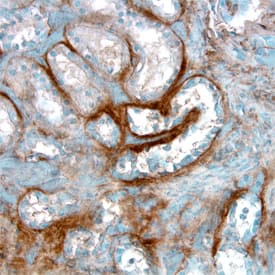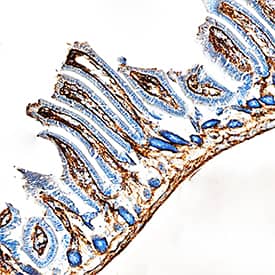Endostatin Products
Endostatin is a 20 kDa proteolytic fragment of the C-terminal, non-collagenous (NC1) domain of type XVIII Collagen. It was originally identified as a factor produced by murine hemangioendothelioma cells that could specifically inhibit endothelial cell proliferation and angiogenesis. Although the molecular signals that trigger the release of Endostatin from type XVIII Collagen are not well understood, multiple proteases have been suggested to be involved in its generation including Cathepsins S, B, L, and V, Elastase, and matrix metalloproteinases (MMPs)-2, -7, and -9. Endostatin is of particular interest as it has been shown to inhibit the growth of many primary and metastatic tumors. It may also be involved in down-regulating angiogenesis during physiological processes such as wound healing and the establishment of placental circulation. The anti-angiogenic activity of Endostatin is attributable to its ability to inhibit endothelial cell proliferation and suppress VEGF-and FGF basic-induced endothelial cell migration and adhesion. Many of these effects are thought to be mediated by interactions between Endostatin and endothelial cell-expressed Transglutaminase 2, Heparin, and Integrins alpha 5 beta 1 and alpha V beta 3.
46 results for "Endostatin" in Products
46 results for "Endostatin" in Products
Endostatin Products
Endostatin is a 20 kDa proteolytic fragment of the C-terminal, non-collagenous (NC1) domain of type XVIII Collagen. It was originally identified as a factor produced by murine hemangioendothelioma cells that could specifically inhibit endothelial cell proliferation and angiogenesis. Although the molecular signals that trigger the release of Endostatin from type XVIII Collagen are not well understood, multiple proteases have been suggested to be involved in its generation including Cathepsins S, B, L, and V, Elastase, and matrix metalloproteinases (MMPs)-2, -7, and -9. Endostatin is of particular interest as it has been shown to inhibit the growth of many primary and metastatic tumors. It may also be involved in down-regulating angiogenesis during physiological processes such as wound healing and the establishment of placental circulation. The anti-angiogenic activity of Endostatin is attributable to its ability to inhibit endothelial cell proliferation and suppress VEGF-and FGF basic-induced endothelial cell migration and adhesion. Many of these effects are thought to be mediated by interactions between Endostatin and endothelial cell-expressed Transglutaminase 2, Heparin, and Integrins alpha 5 beta 1 and alpha V beta 3.
| Sensitivity: | 0.063 ng/mL |
| Applications: | ELISA |
| Assay Range: | 0.31 - 10 ng/mL (Cell Culture Supernates, Serum, EDTA Plasma, Heparin Plasma, Saliva) |
| Assay Range: | 62.5 - 4,000 pg/mL |
| Applications: | ELISA |
| Reactivity: | Human |
| Details: | Goat IgG Polyclonal |
| Applications: | WB, IHC |
| Reactivity: | Mouse |
| Details: | Goat IgG Polyclonal |
| Applications: | WB, IHC |
| Source: | E. coli |
| Accession #: | NP_569712 |
| Applications: | BA |
| Reactivity: | Human |
| Details: | Goat IgG Polyclonal |
| Applications: | WB, IHC |
| Reactivity: | Mouse |
| Details: | Rat IgG2b Monoclonal Clone #91318 |
| Applications: | WB |
| Reactivity: | Human, Mouse, Rat |
| Details: | Mouse IgG Monoclonal Clone #1837.46 |
| Applications: | IHC, WB |
| Reactivity: | Mouse |
| Details: | Goat IgG Polyclonal |
| Applications: | WB |
| Source: | NS0 |
| Accession #: | P39061 |
| Applications: | BA |
For use with catalog numbers DNST0, SNST0, PDNST0
| Applications: | Ctrl |
| Reactivity: | Mouse |
| Details: | Rat IgG2 Monoclonal Clone #RM0060-3H11 |
| Applications: | IHC, WB |
| Applications: | ELISA |
| Reactivity: | Mouse |
| Details: | Rat IgG2 Monoclonal Clone #RM0060-3H11 |
| Applications: | IHC, WB |
| Reactivity: | Human |
| Details: | Rabbit IgG Polyclonal |
| Applications: | IHC |
| Reactivity: | Human |
| Details: | Rabbit IgG Polyclonal |
| Applications: | ICC/IF |
| Applications: | AC |
Contains 4 membranes-each spotted in duplicate with 111 different cytokine antibodies
Contains 4 membranes - each spotted in duplicate with 55 different angiogenesis antibodies
Contains 4 membranes-each spotted in duplicate with 84 different cancer-related antibodies
Contains 4 membranes-each spotted in duplicate with 79 different cytokine antibodies
| Reactivity: | Mouse |
| Details: | Rat IgG2 Monoclonal Clone #RM0060-3H11 |
| Applications: | IHC, WB |
| Reactivity: | Mouse |
| Details: | Rat IgG2 Monoclonal Clone #RM0060-3H11 |
| Applications: | IHC, WB |
Luminex Discovery Assays provide the most flexible assays on the market. These panels are completely customizable using our large menu of human, mouse, and rat analytes, making them the perfect tool for biomarker discovery and screening.
Build your own Luminex Assay with our Luminex Assay Customization Tool.
| Applications: | Bioactivity, PAGE |








![Immunohistochemistry-Paraffin: Endostatin Antibody (1837.46) [NBP1-40051] Immunohistochemistry-Paraffin: Endostatin Antibody (1837.46) [NBP1-40051]](https://resources.bio-techne.com/images/products/Endostatin-Antibody-1837-46-Immunohistochemistry-Paraffin-NBP1-40051-img0001.jpg)
![Immunohistochemistry-Paraffin: Endostatin Antibody (RM0060-3H11) - Azide and BSA Free [NBP2-12274] Immunohistochemistry-Paraffin: Endostatin Antibody (RM0060-3H11) - Azide and BSA Free [NBP2-12274]](https://resources.bio-techne.com/images/products/Endostatin-Antibody-RM0060-3H11-Immunohistochemistry-Paraffin-NBP2-12274-img0001.jpg)
![Mouse Endostatin ELISA Kit (Colorimetric) [NBP3-26055] -](https://resources.bio-techne.com/images/products/nbp3-26055_mouse-endostatin-elisa-kit-colorimetric-6220241542190.png)

![Immunohistochemistry-Paraffin: Endostatin Antibody [NBP3-17655] Immunohistochemistry-Paraffin: Endostatin Antibody [NBP3-17655]](https://resources.bio-techne.com/images/products/Endostatin-Antibody-Immunohistochemistry-Paraffin-NBP3-17655-img0001.jpg)
![Immunocytochemistry/ Immunofluorescence: Endostatin Antibody [NBP2-55015] Immunocytochemistry/ Immunofluorescence: Endostatin Antibody [NBP2-55015]](https://resources.bio-techne.com/images/products/Endostatin-Antibody-Immunocytochemistry-Immunofluorescence-NBP2-55015-img0001.jpg)




![SDS-PAGE: Recombinant Human Endostatin Protein [NBP2-34974] SDS-PAGE: Recombinant Human Endostatin Protein [NBP2-34974]](https://resources.bio-techne.com/images/products/Recombinant-Human-Endostatin-Protein-SDS-Page-NBP2-34974-img0002.jpg)